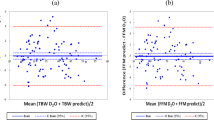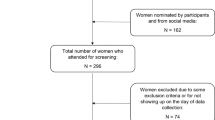Abstract
Objective:
To develop bioelectrical impedance analysis (BIA) equations to predict total body water (TBW) and fat-free mass (FFM) of Sri Lankan children.
Subjects/Methods:
Data were collected from 5- to 15-year-old healthy children. They were randomly assigned to validation (M/F: 105/83) and cross-validation (M/F: 53/41) groups. Height, weight and BIA were measured. TBW was assessed using isotope dilution method (D2O). Multiple regression analysis was used to develop preliminary equations and cross-validated on an independent group. Final prediction equation was constructed combining the two groups and validated by PRESS (prediction of sum of squares) statistics. Impedance index (height2/impedance; cm2/Ω), weight and sex code (male=1; female=0) were used as variables.
Results:
Independent variables of the final prediction equation for TBW were able to predict 86.3% of variance with root means-squared error (RMSE) of 2.1 l. PRESS statistics was 2.1 l with press residuals of 1.2 l. Independent variables were able to predict 86.9% of variance of FFM with RMSE of 2.7 kg. PRESS statistics was 2.8 kg with press residuals of 1.4 kg. Bland Altman technique showed that the majority of the residuals were within mean bias±1.96 s.d.
Conclusions:
Results of this study provide BIA equation for the prediction of TBW and FFM in Sri Lankan children. To the best of our knowledge there are no published BIA prediction equations validated on South Asian populations. Results of this study need to be affirmed by more studies on other closely related populations by using multi-component body composition assessment.
This is a preview of subscription content, access via your institution
Access options
Subscribe to this journal
Receive 12 print issues and online access
$259.00 per year
only $21.58 per issue
Buy this article
- Purchase on Springer Link
- Instant access to full article PDF
Prices may be subject to local taxes which are calculated during checkout





Similar content being viewed by others
References
Baumgartner RN (1996). Electrical impedance and total body electrical conductivity. In: Roche AF, Heymsfield SB, Lohman TG (eds). Human Body Composition. Human Kinetics: Champaign, IL. pp 79–107.
Bell NA, McClure PD, Hill RJ, Davies PSW (1998). Assessment of foot-to-foot bioelectrical impedance for the prediction of total body water. Eur J Clin Nutr 52, 856–859.
Bland JM, Altman DG (1986). Statistical methods for assessing agreement between two methods of clinical measurement. Lancet 1, 307–310.
Cordain L, Whicker RE, Johnson JE (1988). Body composition determination in children using bioelectrical impedance. Growth Dev Aging 52, 37–40.
Davies PSW, Preece MA, Hicks CJ, Halliday D (1988). The prediction of total body water using bioelectrical impedance in children and adolescents. Ann Hum Biol 15, 237–240.
Fjeld CR, Freundt-Thurne J, Schoeller DA (1990). Total body water measured by 18O dilution and bioelectrical impedance in well and malnourished children. Pediatr Res 27, 98–102.
Guo SS, Chumlea Wm C (1996). Statistical methods for the development and testing of predictive equations. In: Roche AF, Heymsfield SB, Lohman TG (eds). Human Body Composition. Human Kinetics: Champaign, IL. pp 191–202.
Halliday D, Miller AG (1977). Precise measurement of total body water using trace quantities of deuterium oxide. Biomed Mass Spectrom 4, 82–87.
Houtkooper LB, Going SB, Lohman TG, Roche AF, Van Loan M (1992). Bio-electrical impedance estimation of fat-free body mass in children and youth: a cross-validation study. J Appl Physiol 72, 366–373.
Lohman TG (1989). Assessment of body composition in children. Ped Exer Sci 1, 19–30.
Lohman TG (1992). Advances in Body Composition Assessment (Monograph no. 3) Human Kinetic: Champaign IL.
McCarthy HD, Cole TJ, Fry T, Jebb SA, Prentice AM (2006). Body fat reference curves for children. Int J Obes 30, 598–602.
National Institutes of Health Technology Assessment Conference Statement 1994 Dec 12–14 (1996). Bioelectrical impedance analysis in body composition measurement. Am J Clin Nutr 64 (Suppl 3), 524S–532S.
Schaefer F, Georgi M, Zieger A, Scharer K (1994). Usefulness of bioelectrical and skinfold measurements in predicting fat-free mass derived from total body potassium in children. Pediatr Res 35, 617–624.
Schoeller DA, Van Santen E, Peterson DW, Dietz W, Jaspan J, Klein PD (1980). Total body water measurement in humans with 18O and 2H labeled water. Am J Clin Nutr 33, 2686–2692.
Sun SS, Chumlea WC, Heymsfield SB, Lukaski HC, Schoeller D, Friell K et al. (2003). Development of bioelectrical impedance analysis prediction equations for body composition with the use of a multi-component model for use in epidemiological surveys. Am J Clin Nutr 77, 331–340.
Thomasset M (1962). Bio-electrical properties of tissue impedance measurements. Lyon Med 207, 107–118.
WHO Technical Report Series-89 (2000). Obesity: Preventing and Managing the Global Epidemic. WHO: Geneva.
Wickramasinghe VP, Lamabadusuriya SP, Atapattu N, Sathyadas G, Kuruparanantha S, Karunarathne P (2004). Nutritional status of schoolchildren in an urban area of Sri Lanka. Cevlon Med J 49, 114–118.
Wickramasinghe VP, Cleghorn GJ, Edmiston KA, Murphy AJ, Abbott RA, Davies PSW (2005). Ability of bioelectrical impedance to predict percentage fat mass in children of two different ethnic origins. Int J Body Comp Res 3, 15–24.
Acknowledgements
We are grateful to all subjects and their parents for participating in this study. We are also grateful to Dr Samanmali Sumanasena for assistance with data collection.
This study was carried out with the financial support from Children's Nutrition Research Centre, Discipline of Paediatrics and Child Health, School of Medicine University of Queensland, Brisbane, Australia.
Author information
Authors and Affiliations
Corresponding author
Rights and permissions
About this article
Cite this article
Wickramasinghe, V., Lamabadusuriya, S., Cleghorn, G. et al. Assessment of body composition in Sri Lankan children: validation of a bioelectrical impedance prediction equation. Eur J Clin Nutr 62, 1170–1177 (2008). https://doi.org/10.1038/sj.ejcn.1602835
Received:
Revised:
Accepted:
Published:
Issue Date:
DOI: https://doi.org/10.1038/sj.ejcn.1602835
Keywords
This article is cited by
-
The effect of foetal and early childhood growth on metabolic derangements of Sri Lankan children
BMC Pediatrics (2023)
-
Assessment of body composition in Sri Lankan adults: development and validation of bioelectrical impedance prediction equation
European Journal of Clinical Nutrition (2020)
-
Bioelectrical impedance analysis for body composition assessment: reflections on accuracy, clinical utility, and standardisation
European Journal of Clinical Nutrition (2019)
-
Assessing the reliability of FTIR spectroscopy measurements and validity of bioelectrical impedance analysis as a surrogate measure of body composition among children and adolescents aged 8–19 years attending schools in Kampala, Uganda
BMC Public Health (2018)
-
Development and validation of bioelectrical impedance analysis equations for prediction total body water and fat-free mass using D2O technique in Moroccan children aged between 8 and 11 years old
European Journal of Clinical Nutrition (2018)



